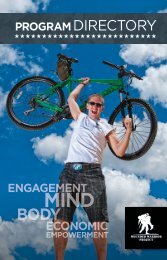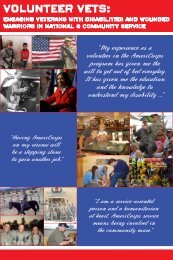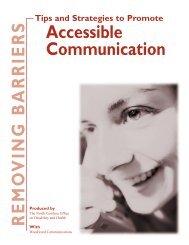Paths to Inclusion - Mitsubishi Electric America Foundation
Paths to Inclusion - Mitsubishi Electric America Foundation
Paths to Inclusion - Mitsubishi Electric America Foundation
You also want an ePaper? Increase the reach of your titles
YUMPU automatically turns print PDFs into web optimized ePapers that Google loves.
about <strong>Paths</strong> <strong>to</strong> inclusionOn their pathway in life, young people often participate in avariety of extracurricular activities, from sports <strong>to</strong> clubs <strong>to</strong>internships. But for youth with disabilities, opportunitiesmay be few or available only in segregated settings.This publication is designed as a guide <strong>to</strong> expanding thoseopportunities by helping you—as a youth program leader orvolunteer—learn how <strong>to</strong> make your organization fully accessible <strong>to</strong>all young people. In many cases, the adjustments needed are modestand low-cost, yet may have a big impact. Through inclusion, you canhelp a young person with a disability get on the path <strong>to</strong> a productive,and fulfilling life.Thanks <strong>to</strong> the pioneering work of organizations such as those featuredin this brochure, there’s a wide range of inclusion resources and bestpractices <strong>to</strong> draw on. <strong>Inclusion</strong> is the right thing <strong>to</strong> do, and the besttime <strong>to</strong> start is RIGHT NOW!Pho<strong>to</strong> by Melissa RoederA publication of the11560 Wilson Blvd., Suite 1150 • Arling<strong>to</strong>n, VA 22209www.meaf.org
What is <strong>Inclusion</strong>?<strong>Inclusion</strong> is an attitude and approachIn-clu-sion (in-kloo-zhun), n – an attitude and approach that seeks <strong>to</strong> ensure that everyperson, regardless of ability or background, can meaningfully participate in all aspectsof life.<strong>Inclusion</strong> means:• offering the same opportunities forpeople with and without disabilities• welcoming everyone• building community• emphasizing cooperation• seeking <strong>to</strong> understand andaccommodate differences• providing a safe and sociallycomfortable environment for all• teaching respect, understanding anddignity <strong>to</strong> people of all abilities• embracing changes that facilitate fullparticipation• actively reaching out <strong>to</strong> people who aretraditionally excluded or marginalized• fostering a sense of belonging <strong>to</strong>community as a respected andvalued peer• honoring the intrinsic value ofeach person’s life<strong>Inclusion</strong> is an approach, not a program.An attitude, not an activity.<strong>Inclusion</strong> is belonging!“I didn’t know that someone in awheelchair could do so much! I learnedthat the only limitations we have arelimits we put on ourselves.”Sources:Ace Disabilitywww.acedisability.org.au/inclusion/CASTwww.cast.orgKids Included Togetherwww.ki<strong>to</strong>nline.org<strong>Inclusion</strong> Networkwww.inclusion.comTASHwww.tash.orgWilderness Inquirywww.wildernessinquiry.org– Mike speaking about a friendat camp3
Case in Point: Disability basicsWhat is Asperger’s syndrome? How can Icommunicate with a deaf child? What snacks canwe serve kids with diabetes? What about restroomsfor children in wheelchairs?There are many questions that naturally arise when youfirst consider bringing youth with disabilities in<strong>to</strong> yourorganization. You don’t have <strong>to</strong> be a disability expert,but there are resources that provide information you mayneed <strong>to</strong> understand the general characteristics of specificdisabilities (see T r a i l M a r k e r ).Brownies learn aboutreading Braille fromMikaila, who is visuallyimpaired.The most important point is <strong>to</strong> identify whataccommodations, if any, the child might need. Anaccommodation is any item or action that helpsthe individual fit in and fully participate. Glasses,hearing aids, and wheelchairs are some commonaccommodations. Others might include using picturesinstead of verbal descriptions, reading instructions aloud,or making sure ramps are available at access points.The kids themselves and their parents can usually tellyou exactly what accommodations they need. Keepin mind that the ADA does not obligate you <strong>to</strong>fundamentally change a program if the expense isunreasonable or <strong>to</strong> offer personal services unless theyare normally provided <strong>to</strong> all.T r a i l M a r k e rCommon disabilitiesKnowledge of common disability traits can be helpful.Wilderness Inquiry has developed a database of disabilities that are common amongyouth.The database gives a brief description of 40 types of disability, with links <strong>to</strong> moreinformation, <strong>to</strong> deepen understanding of a disability. Remember that each individual isunique, and while there may be typical characteristics of a disability, each person mayhave different needs… or possibly none at all.To link <strong>to</strong> the database, visit:www.IncludingAllKids.org/disability_infoSource: www.wildernessinquiry.org/programs/scouts/youth_disabilities.php
Why <strong>Inclusion</strong>?<strong>Inclusion</strong> is the right thing <strong>to</strong> doAccording <strong>to</strong> the U.S. Census Bureau, 54 million <strong>America</strong>ns—one in five—havea disability. And through birth, accident, age or illness, nearly everyone willexperience disability during their lifetime. In order <strong>to</strong> protect the rights of peoplewith disabilities, Congress passed a law in 1990—the <strong>America</strong>ns with DisabilitiesAct (ADA).The ADA is most often associated with curb cuts and accessible bathrooms, but italso mandates that public programs be accessible. Program providers can learn aboutthe ADA and other laws by visiting www.IncludingAllKids.org. But inclusion ismore than just laws. Laws cannot mandate attitudes or commitment. <strong>Inclusion</strong> is theethical and moral thing <strong>to</strong> do.Compared <strong>to</strong> youth without disabilities, twice as many young people with disabilitieslive in poverty and twice as many drop out of high school, with a significant numberending up in prison. These numbers are sobering, but should not be discouraging.Studies indicate that when youth with disabilities are given the opportunity <strong>to</strong>participate in community activities, such statistical trends can be reversed.By using some of the ideas and best practices cited in this publication, you can begin<strong>to</strong> make change happen.Pho<strong>to</strong> by Greg Lais“I was <strong>to</strong>ld by a lot ofpeople, ‘You can’t doadventurous things. Berealistic, you’re blind.’But Wilderness Inquirygave me a chance <strong>to</strong>prove them wrong. No<strong>to</strong>nly did I participate, butI got <strong>to</strong> lead the groupthrough a cave.”- Mia talking about herexperience cavingWildernessInquiry5
Case in Point: Everyone benefitsBy dispelling myths and working <strong>to</strong> reduce real andattitudinal barriers <strong>to</strong> inclusion, program providersquickly discover that everyone benefits from inclusion.• Myth: <strong>Inclusion</strong> costs <strong>to</strong>o much.Reality: <strong>Inclusion</strong> is mandated by law, so it shouldbe considered a cost of doing business. However,most accommodations are actually low cost, andoften the young person already has the adaptiveequipment he or she needs.• Myth: Including kids with disabilities willcompromise the quality of the program for others.Reality: Time and again, inclusion is shown <strong>to</strong>benefit all youth and raise program quality overall.• Myth: If a young person has a certain type ofdisability, there are things he or she can’t do.Reality: While there may be traits typical ofspecific disabilities, every individual is unique.Always start by assuming someone can dosomething. And always respect the person’sindividuality. That starts with using person-firstlanguage (see T r a i l M a r k e r ).Often people withcognitive disabilitiesare placed in low-skill,set-aside jobs, but notAnnie. She works atCincinnati Children’sHospital Medical Centerperforming a complex,competitive job. Annielives independently andsupports herself throughher work.T r a i l M a r k e rPerson-first languageWords are powerful! Words reflect our feelings and thoughts. When speaking abouta person with a disability, always put the person first and stress people’s abilities. It isnot about political correctness; it is about respect and dignity.Say…Person with a disabilityTom has autismSarah is a little personJim uses a wheelchairShe needs…Kids without disabilitiesInstead of…The handicappedHe’s autisticShe’s a dwarf/midgetHe’s wheelchair boundShe has special needsNormal/typical kidsSource: www.disabilityisnatural.com Adapted and used with permission.
Case in Point: <strong>Inclusion</strong>begins with “I”<strong>Inclusion</strong> begins with “I.” So ask yourself:“What can I do <strong>to</strong> help make my organizationmore inclusive?” The key is <strong>to</strong> start with theindividual.First, determine each individual’s needs andstrengths. Then, balance those needs andutilize those strengths <strong>to</strong> develop a qualityexperience for the group. Implementingthe Seven Steps of <strong>Inclusion</strong> (see T r a i lM a r k e r ) will help your organization onthe path <strong>to</strong> create an environment where groupgoals are achieved in a safe and fun manner,and each individual is welcomed, respected,and fully engaged.Pho<strong>to</strong> by Greg LaisMargo, using a wheelchair,and Steve, with cerebralpalsy, form a symbioticrelationship <strong>to</strong> cross terrainneither could navigate alone.T r a i l M a r k e rSeven Steps of <strong>Inclusion</strong>1: Respect each person’s dignity: When individuals know they are valued, they will morereadily help attain group goals.2: Maintain open lines of communication: Encourage frank and honest discussion aboutneeds and expectations, while respecting confidentiality.3: Promote integrated decision making: The group can help develop solutions <strong>to</strong> meet needs,with each individual becoming invested in the decision making process.4: Emphasize all contributions: Individuals should each have a role, recognizing contributionswhen their ability is used.5: Focus on group challenges and activities: Emphasize cooperation vs. competition with apositive attitude.6: Identify and delegate tasks: Break tasks in<strong>to</strong> steps; ensure each task is a legitimate function;set people up for success.7: Develop symbiotic relationships: Identify complementary individual strengths, matchingpeers <strong>to</strong> achieve group goals.Source: www.wildernessinquiry.org Adapted and used with permission.
inclusion in action<strong>Inclusion</strong> is happening nowA number of youth-serving organizations are developing programs and practices <strong>to</strong>attract and accommodate youth with disabilities. Following is a partial list. Youcan find examples of successful strategies developed by these organizations atwww.IncludingAllKids.org.Academy for Educational DevelopmentBig Brothers Big SistersBoy Scouts of <strong>America</strong>Boys & Girls Clubs of <strong>America</strong>Camp Fire USAChabot Space and Science CenterCity YearGirl Scouts of the USAImagination StageMass Men<strong>to</strong>ringMinnesota Conservation CorpsNational 4-H CouncilNational AfterSchool AssociationNational Recreation and Park AssociationNational Wildlife FederationOperation Fresh StartThe After-School CorporationThe Corps NetworkThe Washing<strong>to</strong>n CenterUtah Conservation CorpsWilderness InquiryYMCA“Since taking a more inclusiveapproach <strong>to</strong> marketing, we have seenan increase in membership of kids withdisabilities in the Boys & Girls Club.Making a few small changes has madethe Club more welcoming.“Kids with and without disabilitieshave formed new and lastingfriendships…Creating an inclusiveenvironment is teaching our children<strong>to</strong> embrace the diverse community inwhich we all live.”- Kelly, speaking about the Boys &Girls Club she directs9
Case in Point: More thanjust rampsChildren and their families should feel welcomefrom the minute they walk in your door, look at yourwebsite, or open your brochure. Some examples ofways <strong>to</strong> help create a welcoming environment:• Assess your facility <strong>to</strong> ensure it is accessible.Remove barriers and make modifications that reflectinclusive practices (see T r a i l M a r k e r ).• Ensure that children and adults with disabilities arerepresented in print and web material. Show pho<strong>to</strong>sof real-life inclusion.• Have your website reviewed <strong>to</strong> ensure that it meetsaccessibility standards.http://webxact.watchfire.com/• Provide marketing materials and application forms inalternative formats (such as Braille, large print, andon CD).• Educate staff and volunteers about inclusion andmake inclusion a part of all trainings.T r a i l M a r k e rAn organizational assessmentPho<strong>to</strong> by Kate GottliebUsing a simpleand inexpensiveaccommodation, Erinparticipates in a hikewith her friends.Recruitment: Are all made <strong>to</strong> feel welcome?TO O L B OX❏❏❏Marketing materials reflect inclusionWebsite is accessibleMaterials available in different formatsFacility: Can everyone be included?❏❏❏Building is accessibleRestrooms are accessiblePublic/accessible transportation is availableProgram: Is everyone prepared for inclusion?❏❏❏❏❏❏Staff and volunteers are trainedPolicies/procedures promote inclusivenessActivities are adapted <strong>to</strong> include allPeer support/friendships are facilitatedAccomplishments are recognizedCurriculum is designed for universal accessSource: www.ki<strong>to</strong>nline.org Adapted and used with permission.11
ResourcesIncludingAllKids.orgwww.IncludingAllKids.org features links<strong>to</strong> these and other inclusion resources.EDUCATIONNational Dissemination Center forChildren with DisabilitiesCentral source for disability-related educationinformation www.nichcy.orgGeorge Washing<strong>to</strong>n UniversityHEATH Resource Center online clearinghousefor post-secondary education for individualswith disabilities www.heath.gwu.eduLEADERSHIPNational Consortium on Leadership &Development for YouthYouth-led resource, information, and trainingcenter for youth and emerging leaders withdevelopmental disabilitieswww.iel.org/programs/ncldy.htmlNational Youth Leadership NetworkNational voice for young leaders withdisabilities www.nyln.orgOUT-OF-SCHOOL TIMEKids Included Together NationalTraining Center on <strong>Inclusion</strong>Providing best practices training on inclusionfor community-based youth organizationswww.ki<strong>to</strong>nline.orgSPORTSDisabled Sports/USAOffers sports rehabilitation and youthmen<strong>to</strong>ring programwww.dsusa.orgSpecial OlympicsEngaging youth with and withoutdevelopmental disabilities through unifiedsports programswww.specialolympics.orgOUTDOOR RECREATIONInclusive Recreation Resource CenterSUNY CortlandPromoting participation by people withdisabilities in inclusive recreation activitieswww.cortland.edu/nysirrcNational Institute onRecreation <strong>Inclusion</strong>Sponsored by the National Recreation and ParkAssociation, NIRI offers an opportunity <strong>to</strong>learn about the inclusion process in recreationalsettings www.nrpa.org/niriNational Wildlife FederationHappenin’ Habitats teaches teachers andstudents how <strong>to</strong> create an accessible outdoorclassroom.http://happeninhabitats.pwnet.orgWilderness InquiryOffers adventure programs for people of allages, skill levels, and abilitieswww.wildernessinquiry.orgVOLUNTEERING & SERVICENational Service <strong>Inclusion</strong> ProjectProvides technical assistance <strong>to</strong> nationalservice program providerswww.serviceandinclusion.org11
The Corps NetworkNational association of service and conservation crewsoffering an Inclusive Crew Modelwww.corpsnetwork.orgMENTORINGPartners for Youth with DisabilitiesMen<strong>to</strong>ring programs for youth with disabilitieswww.pyd.orgINTERNSHIPSEmerging LeadersSummer Internships for youth with disabilitieswww.emerging-leaders.comMEAF-AAPD Congressional Internships &Microsoft-AAPD Federal IT InternshipsPlacing college students with disabilities in summerinternships in Washing<strong>to</strong>n, DC www.aapd.comYouth <strong>to</strong> Work CoaltionSponsored by the US Business Leadership Network, theYWC promotes internships and men<strong>to</strong>ring opportunitiesfor youth with disabilitieswww.usbln.org/youth<strong>to</strong>work/default.aspxPho<strong>to</strong> by Tom WilliamsAs a college student,Stacy interned onCapi<strong>to</strong>l Hill throughthe MEAF-AAPDCongressional InternshipProgram. Aftergraduating she washired as a LegislativeCorrespondent forSena<strong>to</strong>r Brownback ofKansas. Stacy, who isblind, leads <strong>to</strong>urs of theU.S. Capi<strong>to</strong>l Buildingamong her otherlegislative duties.EMPLOYMENTCareer Opportunities for Studentswith DisabilitiesCareer planning services for college students withdisabilities www.cosdonline.orgJob Accommodation NetworkFree consulting service that provides information onaccommodations and disability employmentwww.jan.owvu.eduProject SEARCHUnique employment training for youth and adults withcognitive disabilitieswww.cincinnatichildrens.org/ps13
ResourcesINCLUSIONIncluding All KidsComprehensive listings of youth-related inclusionresources and best-practices www.includingallkids.org<strong>Inclusion</strong> NetworkCincinnati-based umbrella group working <strong>to</strong> raiseawareness of inclusion www.inclusion.orgInclusive men<strong>to</strong>ring &internships can help kidsprepare for work, careers& independent livingCompanies such as <strong>Mitsubishi</strong><strong>Electric</strong> and Microsof<strong>to</strong>ffer men<strong>to</strong>rs and internshipprograms which can helpyouth with disabilitiestransition from school <strong>to</strong>work. Bos<strong>to</strong>n-based Partnersfor Youth with Disabilities(PYD) has developed a freeguidebook, Best Practicesfor Men<strong>to</strong>ring Youthwith Disabilities, <strong>to</strong> helporganizations implementinclusive men<strong>to</strong>ringopportunities:www.pyd.org/nationalcenter/index.htm.INDEPENDENT LIVINGNational Council on Independent LivingNational association of independent living centerswww.ncil.orgTASHMembership association that promotes the full inclusionof people with disabilities in society www.tash.orgDISABILITYDisabilityInfo.govComprehensive resource on governmental servicesavailable <strong>to</strong> people with disabilitieswww.disabilityinfo.govDisability Funders NetworkAn affinity group of disability funderswww.disabilityfunders.orgEaster SealsDedicated <strong>to</strong> helping children and adults with disabilitiesattain greater independencewww.easterseals.comUnited Cerebral Palsy (UCP)Leading source of information on cerebral palsy andoffers comprehensive resources for persons with anydisability. www.ucp.org/13
<strong>Inclusion</strong> Task ForceBoys & Girls Clubs of <strong>America</strong>Marvin LasterCity of Eden Prairie, MNCarla KressThe Corps NetworkSally Prouty • Kara SmithGirl Scouts of the USAKate GottliebGeorge Washing<strong>to</strong>n UniversityCarol Kochhar-BryantThe HSC <strong>Foundation</strong>Ryan EasterlyKids Included TogetherTorrie Dunlap<strong>Mitsubishi</strong> <strong>Electric</strong> <strong>America</strong> <strong>Foundation</strong>Kevin R. WebbSUNY CortlandLynn AndersonTASHBarb TraderWilderness InquiryGreg Lais • Amy SandeenPho<strong>to</strong> by Kevin WebbUtah Conservation CrewLeader Andy (pictured in thewheelchair) oversees Americorpsvolunteers doing campsiteaccessibility work for the USForest Service as part of TheCorps Network’s inclusivecrew project.About The <strong>Inclusion</strong> Task ForceThe <strong>Inclusion</strong> Task Force grew out of the <strong>Inclusion</strong> Initiative launched by the<strong>Mitsubishi</strong> <strong>Electric</strong> <strong>America</strong> <strong>Foundation</strong> in 2003. With nearly $6 million in grantsand leveraged funds invested in two dozen youth programs, the Initiative has impactedthe lives of thousands of youth with and without disabilities across the US.The members of the Task Force come from community-based and nationalorganizations serving youth and people with disabilities, as well as from universities,foundations and the public sec<strong>to</strong>r. <strong>Paths</strong> <strong>to</strong> <strong>Inclusion</strong> reflects their experience,expertise, and collaborative efforts.15
Pat h s <strong>to</strong> In c l u s i o nIncludingAllKids.orgTo download or order16<strong>Paths</strong> <strong>to</strong> <strong>Inclusion</strong> visitwww.IncludingAllKids.orgPho<strong>to</strong> by Greg Lais






